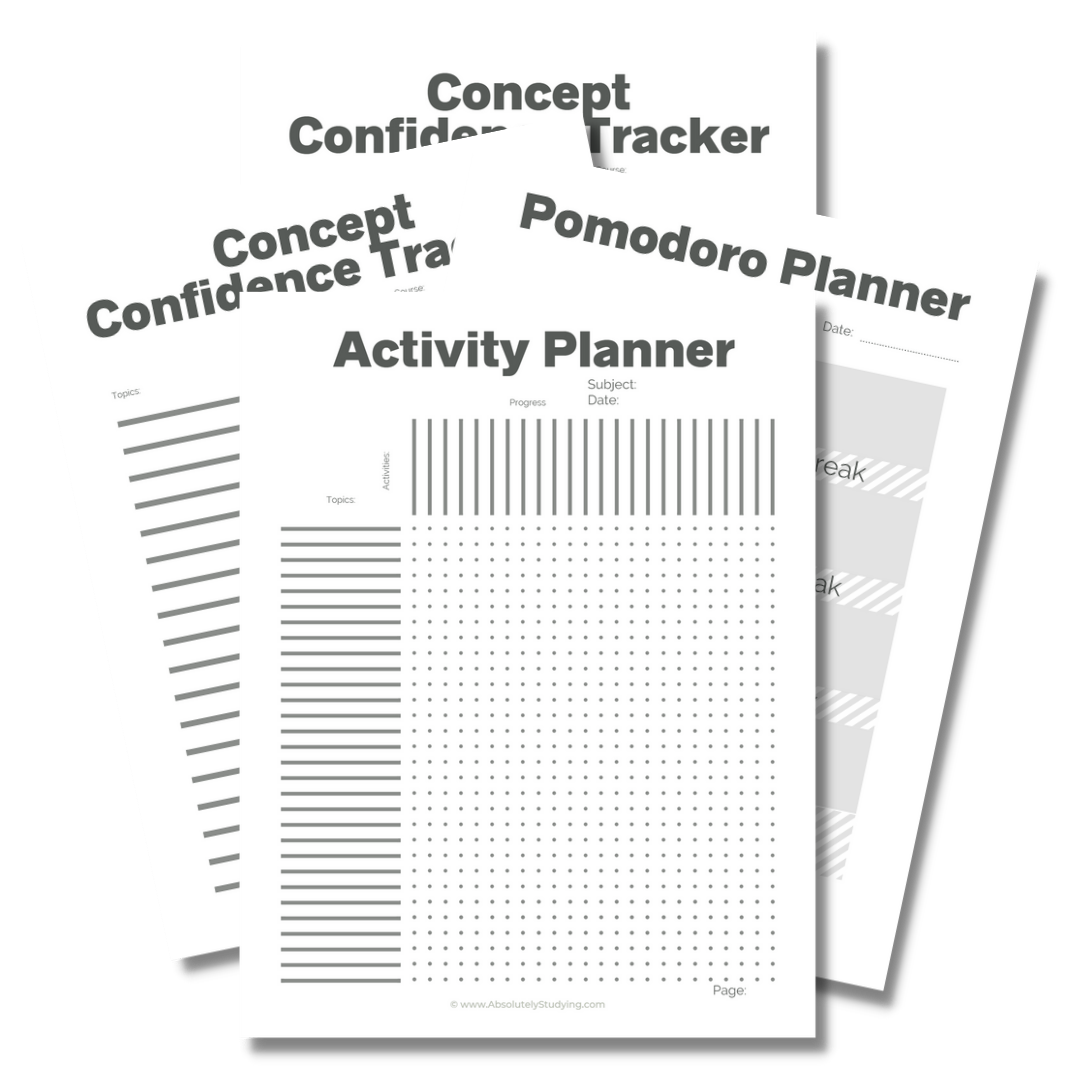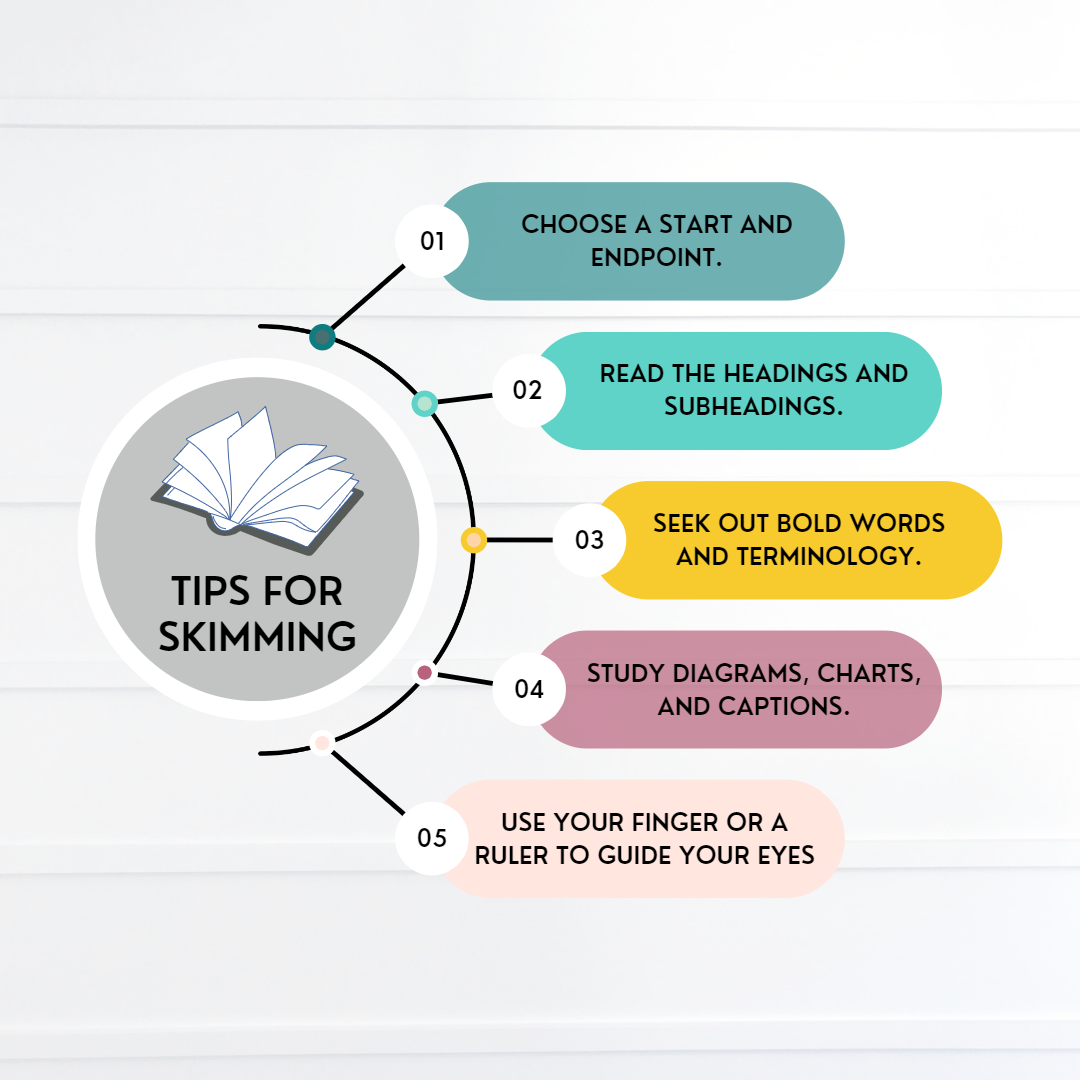How do Skimming and Scanning Improve Reading and Understanding?
Skimming and Scanning Boost Study Sessions!
How to improve reading comprehension with skimming and scanning.
Everything you need for the semester you want!
This bundle includes:
The Syllabus Study Planner
The Pomodoro Planner
A Confidence Tracker
A Q&A planner
The “Get Organized Checklist”
and more!
This workbook is full of super useful resources that can be applied to every aspect of your day.
* Disclaimer * Some of the posted links are affiliate programs. By clicking these links, I may receive monetary compensation. This will not alter the price or change the buyer's experience.
Reading a textbook is boring. It’s hard, and I don’t want to do it. But I have to, and so do you.
Textbooks are dry in college and university. They are fact-filled, incredibly technical, and really not all that interesting. This makes for a challenging read. Transitioning from High School, where you are often taught topics for several classes, and the teacher reviews them painstakingly, is a thing of the past.
Now, the Professor will introduce a subject, give you an overview and then move on, often within the same lecture. It’s then put on you to go home and examine it in detail to learn the material. The responsibility is on you to understand it. Not on the instructor to teach it to you.
This can be jarring for many students, especially in the first year. The classes move very fast. You are expected to learn so much in such a short time while mainly being left on your own. This is why it is so vital to develop efficient study strategies.
Learning the best and most effective study tactics can help you move through the content much faster. This will allow you to review it more often, resulting in better memory retention and recall.
Increasing reading comprehension does not only help with improving your reading skills, but it also translates into doing better on assignments. For example, it can help you better analyze and communicate your supporting arguments when writing essays. This will allow you to better showcase your understanding, translating into better grades.
Today, we are going to break down this approach. By adding the practices of skimming and scanning to your study session, you can boost the efficacy of your reading strategy. We dive deep to find out, what skimming, and scanning are. How they differ from each other, and how they each boost the reading session independently.
Download your free study planner and activity tracker.
Everything you need for the semester you want!
What is Skimming?
Skimming is quickly reading over a section of text to get a general idea of its contents. This is not a thorough read-through. Instead, you are only allowing your eyes to pass over the words while absorbing the general idea of the paragraph.
This practice lets you preview the page’s contents before you actually read it. This is called: Priming. It prepares or “primes” your brain to predict the content to come so that when you actually read the passage, you will already have some familiarity with the information.
When you are skimming:
Choose a start and an endpoint for the piece of text you are going to read.
Begin by looking through it and reading the headings and subheadings.
Go through and read the bold words and vocabulary.
Captions and diagrams can also be surveyed in-depth.
Use your finger to guide you, and quickly pass over or “speed-read” the selected text.
How does skimming improve reading comprehension and vocabulary?
Skimming over a passage is a great way to get a generalized idea of the contents before you read. The idea behind this is that you will pick up some of the information in this first read-through. By skimming through or “priming” yourself on a passage, you will naturally pick up the overall sense of the concept before sitting down and reading it in detail.
Since you already have a generalized idea of what you will learn after skimming, you won’t be learning the concept but reviewing it when you finally read the passage thoroughly. You already know where this journey of information will take you. Now you just need to learn the details of how you get there.
Strategies to improve reading comprehension further:
To make the skimming process even more effective:
Create a list of questions you want to learn about as you read.
Write down this list and try to answer them during your reading session.
As you read, record the answers in your notes.
This will keep you seeking specific details and make you more likely to remember them once you find them.
What is Scanning?
Scanning is when you quickly read over a piece of text to review the material. This is done after you have already read the section carefully. This helps you review and refresh the information after taking it all in.
You will refresh on essential points when you look at the material you have already learned. This is crucial because you will forget much of the new information you learn after walking away from your study session. Scanning a passage regularly will reintroduce these facts, making it more likely that you will remember them in the future.
When you sit down to do a scanning session,
Use your finger to guide you as you “speed-read” over important sections.
You don’t necessarily have to read over the entire section of text again.
Instead, you can limit yourself to going over the essential points you have highlighted.
Make sure you cover vocabulary, names, dates, etc
How does scanning improve reading comprehension and vocabulary?
Scanning is an excellent way to refresh yourself on the information you have already covered. It will help you recall information you might have forgotten since you last covered it.
The unfortunate truth about learning is that you forget about 60% of new material within 24 hours of first learning it. This is without any recall of the subject or intervention. So much study time is wasted, relearning concepts that could have been salvaged in this window. Scanning is a great way to prevent this.
You will retain a little more each time you go over what you have learned. This is because you are exercising the pathways to the knowledge, reinforcing them. So, at test time, you can find it easily.
By simply scanning over your textbook or class notes, you can prevent much of this information from evaporating away. Instead, set aside 5 or 10 minutes to breeze over this material and reinforce it before it has a chance. This will fill in many gaps that start appearing in your memory.
It is common to go over information 3 or even 4 times before the fine details stick. Often, you’ll have to do this in many different ways. You can pick up the free study tracker for 20 study activities you can track to make sure that you are studying each concept effectively.
If you only have time for a quick study session, scanning over your notes or textbook is a perfect way to spend it. This tactic has you reinforcing information you have already learned, enhancing recall. Making it more likely that you will remember these facts, especially during test time. In a time crunch, it’s easier to refresh information you already know than to take in new information.
It takes time and effort to take in new information. You have to open yourself and be receptive to learning, which often can’t really happen in a 5-minute study period. Rather than stumbling through new material during a short study session, save the frustration and review old data.
Hit up the hot spots and review things like names, vocabulary, dates, and flowcharts in your notes. Quiz yourself or read over them and surprise yourself that you forgot some intricate details.
Make sure you add these items to your notes to make it easier to use the scanning method during your next session. Copying these items also adds to improved recall on its own.
Strategies to improve reading comprehension further:
To make a scanning session even more effective, here are some tricks you can try:
Stop at each heading and quiz yourself on the concept you are about to review.
Before each section, try to recall and write down the process or details of the concept before going over it.
Quickly scan over a paragraph to get a general idea, then look away and see if you can fill in the gaps.
Examine diagrams and charts and see if you can recite the passage without reading the captions.
If you write down your responses, you can compare them to the actual answers and see how you measure up. Correcting these mini-quizzes is also a crucial part of the learning process.
How are Skimming and Scanning Different?
Skimming and scanning are incredibly similar, but there are a few key differences. Skimming is done before you start your selected reading to get a general idea of the passage. In contrast, scanning is done afterwards to review essential information.
When skimming, you are previewing or “priming” the information. You are going over it to get the overarching idea of the concept before you drill down on the details. This means you are going over the entire passage.
Scanning is done after you have read through the section of the text. This is to review the details of concepts you have already learned. When scanning, you don’t have to re-examine the entire segment. Instead, you can skip over unimportant information and just review essential facts, diagrams, and charts.
The best approach is to decide on the parameters of what you need to accomplish.
If you only have a short time to study, scanning over concepts is the best approach.
If you have a large section of text to read, you may need to break it into segments and skim over it first.
Both of these processes will amplify the effects of the actual reading session.
Study Skills Digital Course
Learn how to create a stress-free, comprehensive strategy!
Pro-tips for skimming and scanning study sessions.
You should always set clear parameters for what you want to read in a session. This will allow you to break up your reading activities to make the most efficient use of your time.
Make sure you have clear goals in mind. You should have a clear start and endpoint of your reading, the activities you want to do, and how you plan on capturing the information.
Reward yourself. Reading and studying, in general, can be a stressful process. Make sure to take breaks and reward yourself for accomplishing what you set out to do. Some students give themselves a treat for every section of text they read. Others will have a bigger reward in the end. Choose the reward best for you, and make sure to reward yourself. You deserve it!
A session is not a sitting. A study session can last for hours, but in that time, you need to take breaks and switch up material and activities. Your brain will get tired of reading for 8 straight hours, and you will get diminishing gains at some point. Try to switch up your study activity at least hourly to stay engaged.
Take frequent breaks. In addition to switching up activities, give yourself breaks. Your brain needs to rest. Try the Pomodoro Method and take short breaks between focus intervals to refresh your brain and avoid burnout.
Break down chapters into the smallest possible unit. Subheadings are an excellent gauge, but sections can also be a page or several paragraphs. Work through your entire set of reading activities for each section separately.
Skim the sub-topic
Read and highlight
Go back and take notes
Scan it after
Steal My Reading Strategy!
Both skimming and scanning a passage of text are surprisingly effective study strategies. It not only boosts reading comprehension and recall but can also increase the overall speed of reading. This has been proven in studies time and time again, yet, it is a shockingly underused technique.
Introduce skimming as a pre-reading activity to your study session warm-up. This will help you prime your brain and prepare to take in the information you want. You will be more likely to remember it upon reviewing it when you actually read and take notes.
Follow up by scanning your textbook and notes often. This will help you reinforce the links to the information and recall it better during test time. The more often you review and reflect on these concepts, the easier it will be to remember not to forget them.
I would like to be transparent so that there are no misunderstandings. As an affiliate, I may earn a small commission from any products linked in this post. This is not a sponsored post, and I was not asked to recommend these products. These are products that I genuinely love and want to share with my audience.

















